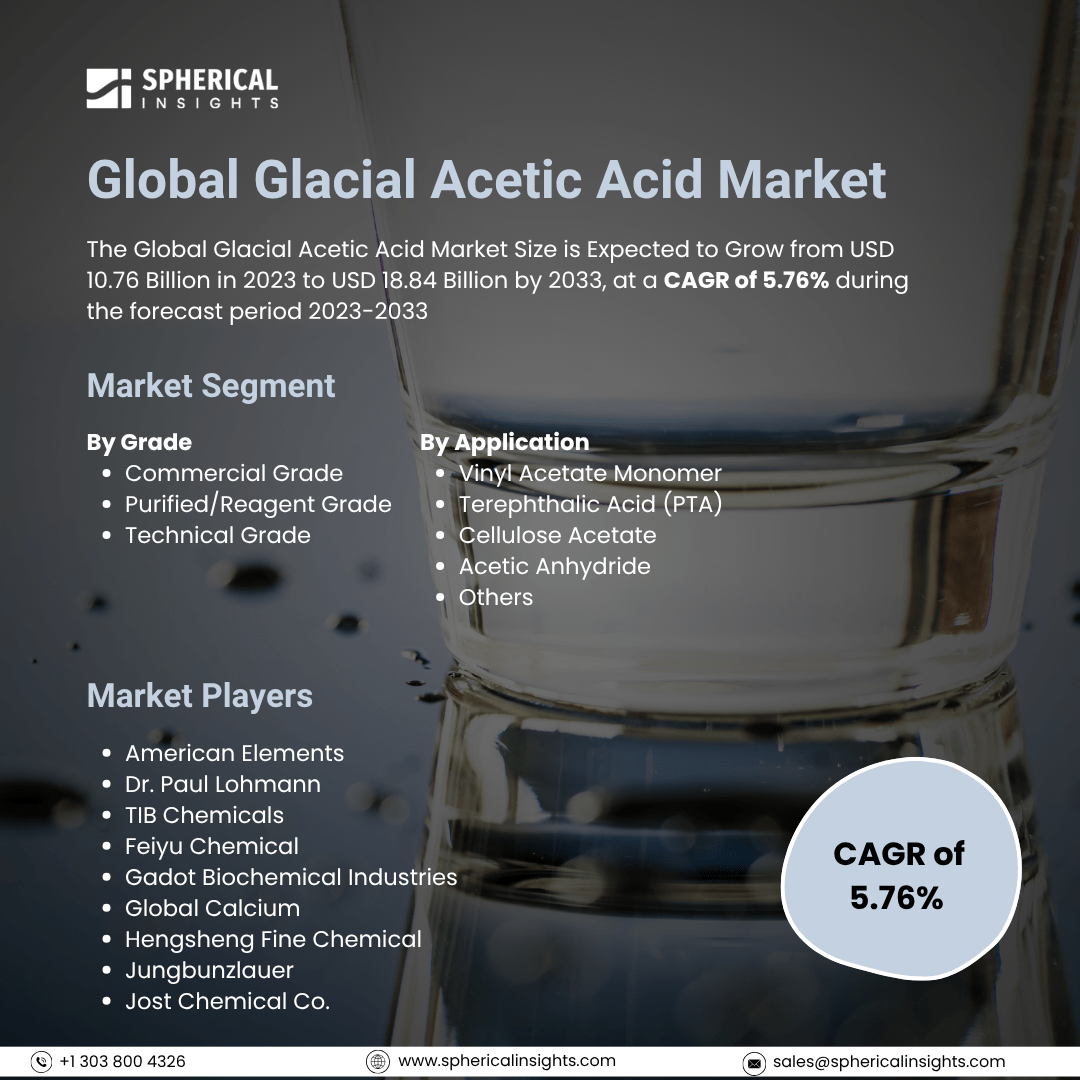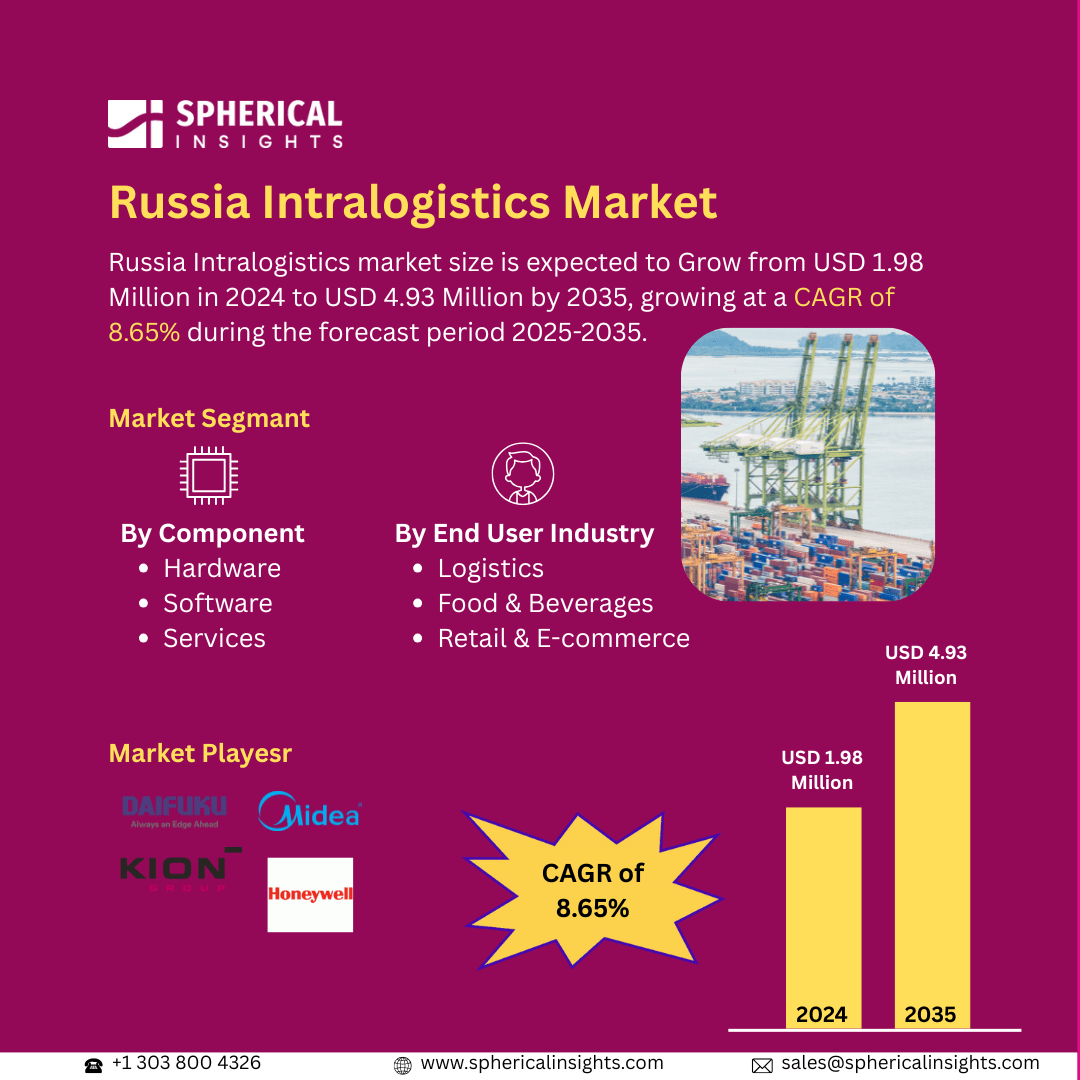Global Glacial Acetic Acid Market Size To Exceed USD 18.84 Billion by 2033
According to a research report published by Spherical Insights & Consulting, The Global Glacial Acetic Acid Market Size is Expected to Grow from USD 10.76 Billion in 2023 to USD 18.84 Billion by 2033, at a CAGR of 5.76% during the forecast period 2023-2033.
Browse 210 Market Data Tables And 45 Figures Spread Through 190 Pages and In-Depth TOC On the Global Glacial Acetic Acid Market Size, Share, and COVID-19 Impact Analysis, By Grade (Commercial Grade, Purified/Reagent Grade, Technical Grade), By Application (Vinyl Acetate Monomer, Terephthalic Acid (PTA), Cellulose Acetate, Acetic Anhydride, Others), and By Region (North America, Europe, Asia-Pacific, Latin America, Middle East, and Africa), Analysis and Forecast 2023 - 2033.
The demand and supply of pure or concentrated acetic acid, also known as anhydrous acetic acid, a colorless, caustic liquid with a potent stench, are referred to as the glacial acetic acid market. This particular type of acetic acid is known as glacial because of its exceptional purity and capacity to crystallize at ambient temperature. Numerous industrial uses, such as the manufacturing of chemicals and vinegar, as well as in the food and pharmaceutical sectors, are driving the market. Manufacturers have a chance to capitalize on consumers' increased desire for sustainable products by meeting the growing need for bio-based glacial acetic acid. The market for glacial acetic acid has a lot of room to grow due to the expansion of the food and pharmaceutical industries, especially in emerging regions. Furthermore, a useful chemical intermediary, glacial acetic acid is used to produce a variety of compounds, including cellulose acetate, vinyl acetate monomer, and acetic anhydride. One of the main raw materials used to make polyvinyl acetate, which is utilized in adhesives, paints, and coatings, is vinyl acetate monomer. However, changes in international trade and logistical limitations might have an impact on pricing and supply stability.
The commercial grade segment dominated the largest share in 2023 and is anticipated to grow at a significant CAGR during the forecast period.
Based on this grade, the global glacial acetic acid market is divided into commercial grade, purified/reagent grade, and technical grade. Among these, the commercial grade segment dominated the largest share in 2023 and is anticipated to grow at a significant CAGR during the forecast period. Cellulose acetate, vinyl acetate monomer, and acetic anhydride are all produced using glacial acetic acid; the market is anticipated to expand at a moderate compound.
The vinyl acetate monomer segment held the highest share in 2023 and is anticipated to grow at a significant CAGR during the forecast period.
Based on the application type, the global glacial acetic acid market is divided into vinyl acetate monomer, terephthalic acid (PTA), cellulose acetate, acetic anhydride, and others. Among these, the vinyl acetate monomer segment held the highest share in 2023 and is anticipated to grow at a significant CAGR during the forecast period. It is utilized to make polyvinyl acetate; adhesives are one of the main uses for vinyl acetate monomers. The shoe, wood, and construction industries all use adhesives. The expansion of the shoe and building sectors is driving up demand for adhesives.
Asia Pacific is anticipated to hold the highest share of the global glacial acetic acid market over the projected period.
Asia Pacific is anticipated to hold the highest share of the global glacial acetic acid market over the projected period. This is because of the rising demand for glacial acetic acid in the cellulose acetate production process, which is used to make photographic films, textiles, and cigarette filters. In addition, the region's market is expanding due to the growing need for glacial acetic acid in the food and beverage sector, specifically in the manufacturing of vinegar and food additives.
North America is estimated to grow at the fastest CAGR of the global glacial acetic acid market during the forecast period. The demand is anticipated to be fueled by growing technological advancements in the production process as well as the expansion of the infrastructure.
Company Profiling
Major vendors in the global glacial acetic acid market are American Elements, Dr. Paul Lohmann, TIB Chemicals, Feiyu Chemical, Gadot Biochemical Industries, Global Calcium, Hengsheng Fine Chemical, Jungbunzlauer, Jost Chemical Co., L.C. Industries, Inc., NOAH Technologies Corporation, Nutracetix, Penglai Marine, Seidler Chemical Co., Inc., Shandong Hengtong Biotechnology, Suqqian Modern Biology Technology, Sucroal, and Xinyang Chemical, and others.
Key Target Audience
- Market Players
- Investors
- End-users
- Government Authorities
- Consulting and Research Firm
- Venture capitalists
- Value-Added Resellers (VARs)
Recent Development
- In March 2023, at its Verbund facility in Zhanjiang, China, BASF began construction on a new industrial complex in the Hong Kong Special Administrative Region (SAR), China. The complex will contain plants for glacial acrylic acid (GAA), butyl acrylate (BA), and 2-ethylhexyl acrylate (2-EHA). With an estimated yearly production capacity of 400,000 metric tons of BA and 100,000 metric tons of 2-EHA, the complex is expected to be operational by 2025.
Market Segment
This study forecasts revenue at the global, regional, and country levels from 2023 to 2033. Spherical Insights has segmented the global glacial acetic acid market based on the below-mentioned segments:
Global Glacial Acetic Acid Market, By Grade
- Commercial Grade
- Purified/Reagent Grade
- Technical Grade
Global Glacial Acetic Acid Market, By Application
- Vinyl Acetate Monomer
- Terephthalic Acid (PTA)
- Cellulose Acetate
- Acetic Anhydride
- Others
Global Glacial Acetic Acid Market, By Regional
- North America
- Europe
- Germany
- UK
- France
- Italy
- Spain
- Russia
- Rest of Europe
- Asia Pacific
- China
- Japan
- India
- South Korea
- Australia
- Rest of Asia Pacific
- South America
- Brazil
- Argentina
- Rest of South America
- Middle East & Africa
- UAE
- Saudi Arabia
- Qatar
- South Africa
- Rest of the Middle East & Africa



